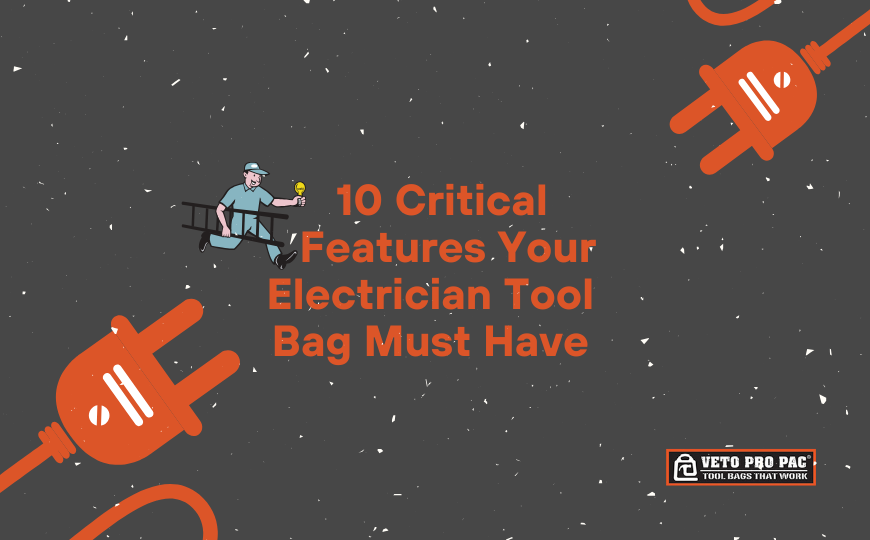A tool bag is an electrician’s mobile workshop and safety barrier. The wrong bag costs you time, damages your gear, and increases your risk on the job.
Electricians face specific challenges: you carry delicate meters, specialized hand tools, and you need fast access in tight spots. Generic bags fail you here. Your electrician tool bag must be an essential piece of equipment. It needs to keep your electrical tool organization perfect, boost your efficiency, and support jobsite safety.
This guide shows you the 10 critical features that separate a professional-grade bag from a cheap disaster. Use this information to choose a bag that works as hard as you do.
1. Specialized Pockets for Electrical Hand Tools
Generic pockets slow you down. Electricians use a precise array of screwdrivers, strippers, and pliers. You need a system that respects that precision.
- Individual Tool Slots: Look for vertical slots and pliers holders that grip each tool firmly. This stops tools from rattling, dulling their edges, or falling out when you open the bag.
- Insulated Tool Protection: The best bags offer material or placement that protects the fragile insulation on your VDE-rated tools.
2. Dedicated Meter and Tester Compartments
Your multimeter and diagnostic testers are expensive and sensitive. Do not let them bang against your hammer and wrenches.
- Padded, Separate Space: You need a multimeter pocket or voltage tester pouch that is padded and physically separate from the heavy hand tool bay. This protects screens and probes from impact.
- Quick and Secure Access: The compartment must close securely—your tester cannot fall out—but you still need to reach it fast. You use these diagnostic tools constantly.
3. Unyielding Material Durability and Weatherproofing
Your job takes you everywhere: wet basements, dusty attics, and outdoor panels. Your bag’s exterior is your first line of defense.
- High-Denier Fabrics: Skip the thin fabric. Demand heavy-duty tool bag fabrics like 1200 or 1680 Denier PVC-impregnated Nylon. These materials resist puncture from sharp tools and stand up to abrasion from concrete.
- Oil and Chemical Resistance: The bag’s body must resist common jobsite contaminants like oil and chemicals. A strong coating protects your tools and keeps the fabric from breaking down.
4. The Indestructible, Waterproof Base
This is the most important feature. The base meets wet floors, debris, and concrete.
- Molded Polypropylene: Choose a molded base tool bag made from injection-molded plastic or rubber. This creates an impenetrable barrier against moisture.
- Stand-Up Design: A tough base gives the bag structural stability. The bag stands upright, even when empty. This stand-up tool bag design prevents spills, keeps your tools visible, and improves your overall efficiency.
5. Ergonomic Carry and Accessibility Systems
You climb ladders, navigate tight openings, and haul gear long distances. How you carry your tools directly affects your body.
- Weight-Distributing Backpacks: If you use a tool backpack, make sure it has thermo-formed, padded back panels and strong shoulder straps. This system moves the weight to your hips, reducing strain on your shoulders.
- Over-Molded Handles: Look for over-molded rubber grips on any handle. This provides a secure, comfortable hold that will not dig into your hand when the bag is fully loaded.
- Hanging Hooks: An integrated internal or external pull-out hook allows you to hang the bag from a beam or a ladder, keeping your tools at chest level and off the floor.
6. Ample Small Parts and Fastener Organization
Wire nuts, screws, terminals, and consumables get lost in big pockets. Finding one lost fastener wastes time.
- Integrated Part Containers: The best electrician tool bags include dedicated, often removable, small parts trays or plastic boxes with lids.
- Magnetic Storage: Look for a magnetic screw catcher or dedicated pocket. This stops loose hardware from spilling when you move the bag.
7. External Attachment Points and Ladder Hooks
You sometimes need to carry things outside the main compartment or secure the bag itself.
- Ladder Straps/Hooks: These straps allow you to secure the bag to a ladder or lift, meeting safety standards and keeping your tools within easy reach.
- Tape Measure Clip: A durable, stainless steel tape measure clip on the exterior is simple but essential for fast access.
- Electrical Tape Strap: A dedicated strap for rolls of electrical tape keeps them organized and quickly accessible without wasting space inside a pocket.
8. High-Visibility Interior and Illumination Options
Working inside a dark panel or basement means you waste time fumbling for black tools in a black bag.
- Bright Interior Lining: A high-visibility interior lining (like light grey or orange fabric) contrasts with dark tool handles. This simple feature drastically improves tool spotting and retrieval time.
- Reflective Accents: If you work near traffic or heavy machinery, bags with reflective strips enhance your personal safety.
9. Security Features (Zipper and Structure)
Your tools are a major investment. You must protect them on a busy jobsite.
- Lockable YKK Zippers: Demand heavy-duty, locking zippers that can accept a small padlock. This deters theft. The zippers should also be made by a reputable brand like YKK and feature oversized tabs you can operate while wearing gloves.
- Rigid Walls: A bag with structural rigidity holds its shape and keeps tools from shifting. This protects them from crushing damage and makes the bag harder to steal or quickly rummage through.
10. Size, Capacity, and Portability Balance
You need the right tool for the job, and the right bag for the job. You will use different bags for different tasks.
- Service Call vs. Installation: A compact electrician tool bag works best for quick service calls, carrying only the essentials. For major installation work, you need a larger tool tote or a large tool backpack that handles bulkier items like coiled wire, cordless drills, and multiple parts boxes.
- Do Not Overpack: The bag should organize your tools. Do not choose a massive bag just because you think you need to carry everything. A great bag limits you to what you need, which saves your back and improves your speed.
Choose Gear Engineered for Your Trade
Do not buy a generic bag and hope it works. Invest in an electrician tool bag that treats your specialized gear with the respect it deserves. Prioritizing these 10 features—from the rugged base to the dedicated meter pockets—means you buy efficiency, tool protection, and safety. A quality bag is a professional investment that pays for itself on the first major job.
Veto Pro Pac for Electricians
Veto Pro Pac bags are designed by tradesmen to meet the demands of the toughest jobs. Here is how specific Veto models match your critical needs:
| Veto Model | Essential Features for Electricians | Ideal Use |
| Tech Pac | Vertical tool storage, center panel design for stability, dedicated padded pockets, injection-molded waterproof base, aluminum hanging hook, ergonomic padded back panel. | Large installations, new construction, long walks, climbing ladders, and when you need your heaviest kit. |
| Tech Pac MC | Compact, hands-free backpack design, 39 total pockets, gray pockets for better visibility, dedicated neoprene meter pockets, locking YKK zippers, 3mm waterproof polypropylene base. | Quick service calls, troubleshooting, tight spaces, and when you need a light, essential kit. |
| TP-XL | Closable one-sided pouch, magnetic screw catcher, metal tape clip, dedicated tablet/document pocket, hard polypropylene base, and a detachable padded shoulder strap. | Mid-sized service kit, aerial lift work, or a specialized kit for low-voltage or specific diagnostics. |
| LC (Large Compact) | Patented center panel organizes 75 hand tools vertically, dual storage bays (two sides), 1800 Denier body fabric, 3mm injection-molded base, and an over-molded rubber grip. | Primary electrician kit, shop bag, or use where maximum, easy-access, vertical organization is key. |

 Tool bags
Tool bags
 Tool Storage
Tool Storage
 Made in USA
Made in USA Tool Bags By Trade
Tool Bags By Trade


